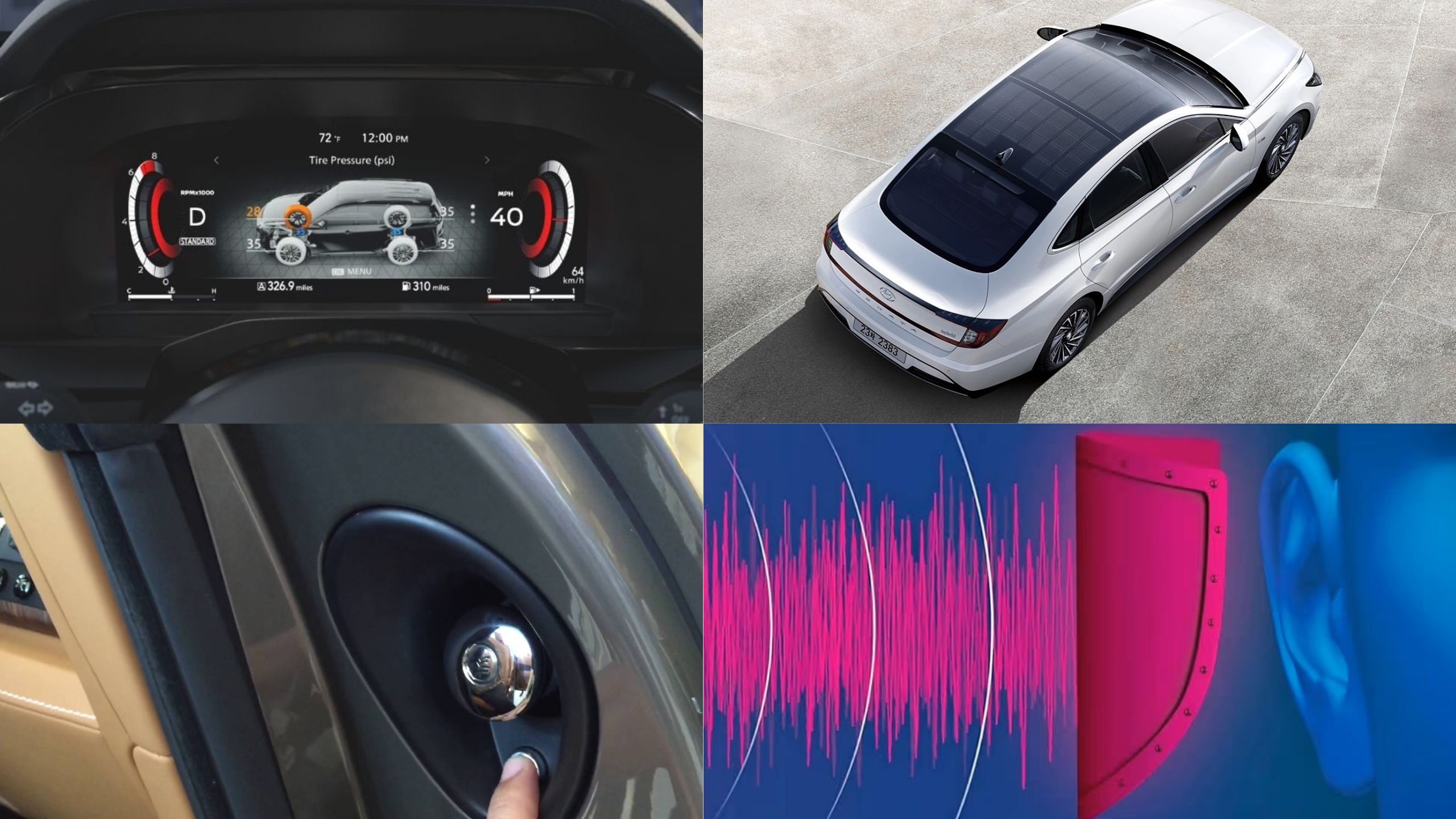Most car owners only scratch the surface of their vehicle’s capabilities, using just a fraction of the features manufacturers have ingeniously built in.
Beyond the obvious controls for climate, audio, and navigation lie numerous hidden gems and thoughtful innovations designed to make driving safer, more convenient, and occasionally more fun.
These lesser-known features range from practical solutions for everyday problems to surprising technological integrations that can transform your driving experience.
Whether you’re driving a family sedan, a luxury vehicle, or an economical compact car, chances are your vehicle harbors several hidden treasures.
Manufacturers often include these features without fanfare, leaving them for owners to discover through experimentation or by poring over their owner’s manual.
This list explores twelve remarkable hidden features found in popular cars across different makes and models’ capabilities that might make you see your vehicle in an entirely new light.
1. Secret Umbrella Compartments in Rolls-Royce and Škoda
The difference between luxury and practicality often lies in the details, and few features demonstrate this better than the hidden umbrella compartments found in both ultra-luxury Rolls-Royce vehicles and the decidedly more accessible Škoda models.
In Rolls-Royce cars, particularly the Phantom and Ghost models, custom-designed umbrellas are discreetly housed within the rear doors.
These aren’t ordinary umbrellas they’re meticulously crafted with the same attention to detail as the vehicles themselves, featuring matching leather handles and the iconic Rolls-Royce monogram.
What makes this feature truly ingenious is the engineering behind it. The compartments contain a sophisticated drying system that automatically activates once the umbrella is returned to its housing, ensuring it’s perfectly dry for its next use regardless of weather conditions.
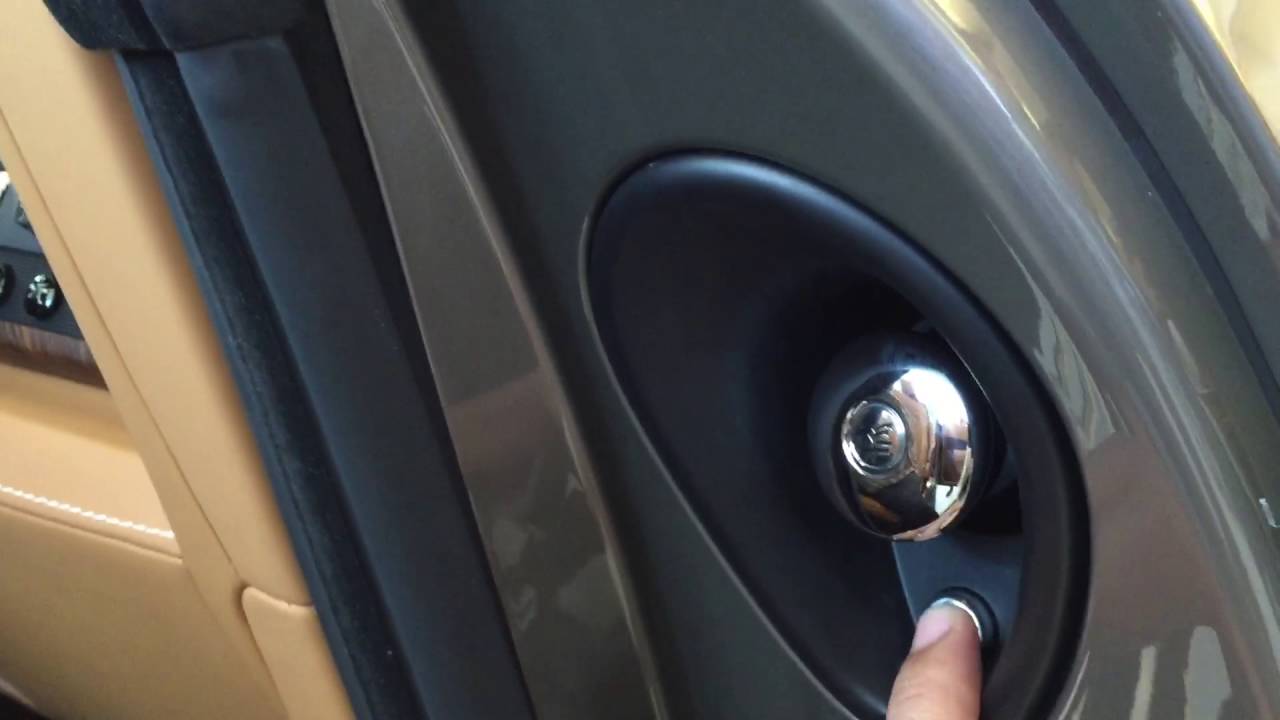
Meanwhile, Czech automaker Škoda has democratized this luxury concept by incorporating similar functionality in their more affordable Superb and Octavia models.
Their umbrella compartments are cleverly integrated into the front doors, with drainage systems to prevent water accumulation.
The Škoda implementation perhaps deserves even more engineering credit, as they’ve managed to incorporate this luxury touch while maintaining reasonable price points.
Both manufacturers recognize that this feature addresses a universal challenge: unexpected rainfall.
There’s something undeniably satisfying about stepping out of your vehicle during a downpour, smoothly retrieving an umbrella from a dedicated compartment, and continuing your journey without missing a beat.
It’s a thoughtful feature that bridges the gap between practicality and luxury, demonstrating that sometimes the most appreciated innovations aren’t flashy technology but rather simple solutions to everyday inconveniences.
2. Honda CR-V’s Hidden Picnic Table
Within the humble Honda CR-V hides one of the most charmingly practical features in automotive design a fully functional picnic table ingeniously integrated into the cargo area.
First introduced in early CR-V models and carried through several generations, this multi-purpose feature remains unknown to many owners.
What appears to be a standard cargo floor panel can be removed, flipped over, and deployed as a sturdy, waterproof table perfect for roadside picnics, tailgating events, or emergency workspace needs.
The engineering behind this feature is deceptively simple yet remarkably effective. The cargo floor panel is constructed with reinforced plastic on one side for durability as a floor, while the reverse features a smooth, flat surface with fold-out legs that lock securely in place when extended.
Honda’s designers clearly understood their target market active families and outdoor enthusiasts who would appreciate multi-functional features that enhance lifestyle activities without adding bulk or complexity to the vehicle.
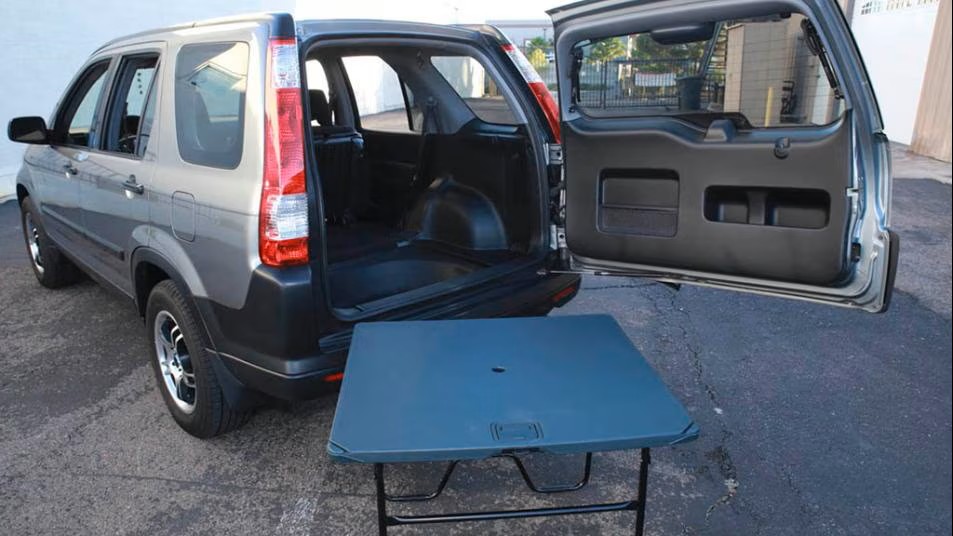
The picnic table weighs just a few pounds but can support substantial weight, making it suitable for food preparation, card games, laptop work, or serving refreshments.
What makes this feature particularly special is its “hidden in plain sight” nature. Many CR-V owners have driven their vehicles for years without discovering this built-in convenience.
Those who do stumble upon it often experience a moment of delighted surprise, as though they’ve uncovered a secret bonus feature in their already-practical SUV.
Honda eventually phased out this feature in newer CR-V generations, replacing it with more technologically advanced amenities.
Yet among Honda enthusiasts, the picnic table remains legendary a perfect example of thoughtful, functional design that raised an everyday vehicle into something with unique character and unexpected utility.
3. BMW’s Secret Button Compartment
Nestled discretely beneath the dashboard of many BMW models lies a hidden compartment that most owners never discover a secret button-activated storage space designed for valuables and small essentials.
This cleverly concealed feature represents BMW’s commitment to both luxury and functionality beyond what meets the eye.
Located typically to the left of the steering wheel, below the light controls, this compartment reveals itself only when a nearly invisible button is pressed.
The panel then smoothly swings open, revealing a felt-lined space approximately the size of a deck of cards.
What makes this feature particularly ingenious is its complete invisibility when closed even passengers familiar with BMW interiors rarely notice its existence.
The compartment was originally designed with European drivers in mind, providing a secure place for highway toll tokens and parking coins.
However, modern owners have repurposed this space for everything from emergency cash and spare keys to memory cards, small medications, or even engagement rings being kept secret until the perfect moment.
Its location makes it accessible to the driver without distracting from the road, yet completely out of sight from casual observers or potential thieves.
BMW’s engineering team designed this feature with typical German precision. The opening mechanism features a satisfying damped action that prevents it from snapping open too quickly, while the closure system secures with a definitive click that confirms proper latching.
The felt lining prevents contents from rattling during driving, maintaining the premium acoustic environment BMW is known for.
What’s particularly fascinating about this feature is how it has persisted through multiple generations of BMW vehicles while remaining virtually undocumented in marketing materials.
It represents BMW’s philosophy that true luxury includes discovering thoughtful details long after the initial purchase small moments of delight that reward the attentive owner and enhance the ownership experience over time.
4. Tesla’s Easter Egg Arcade and Entertainment Features
Beneath Tesla’s cutting-edge electric engineering and autonomous driving capabilities lies a playful side that few automakers have embraced a comprehensive suite of hidden games, entertainment features, and whimsical Easter eggs that transform the driving (or charging) experience in unexpected ways.
At the heart of these features is Tesla Arcade, accessible through the main touchscreen but not immediately obvious to new owners.
This full-fledged gaming platform includes everything from classic Atari games to modern titles like Beach Buggy Racing, where drivers can use their actual steering wheel and pedals as game controllers while parked.
The processing power dedicated to these games isn’t an afterthought Tesla has incorporated serious gaming hardware that rivals dedicated gaming systems.
Beyond gaming, Tesla has hidden numerous Easter eggs throughout their operating system. Say “open butthole” to the voice command system, and the charge port magically opens.
Activate “emissions testing mode,” and you’ve unlocked various flatulence sounds that can be directed to different seats in the vehicle a juvenile but undeniably amusing feature.
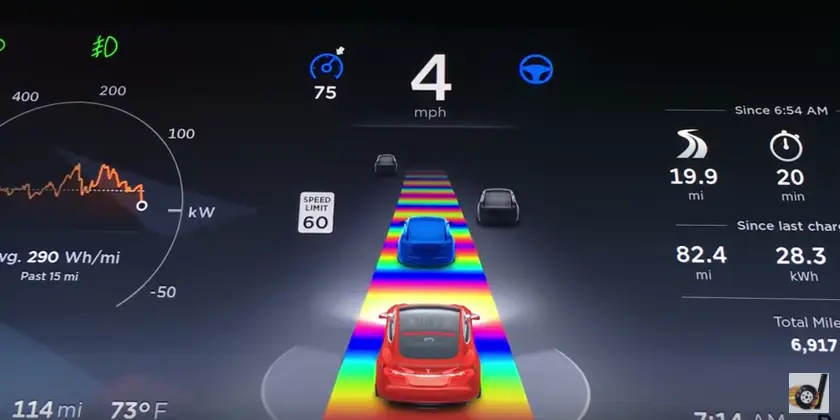
During holidays, “Santa Mode” transforms the navigation display into a sleigh riding across a snowy world, complete with appropriate sound effects.
Perhaps most famous is “Romance Mode,” which transforms the central screen into a virtual fireplace complete with crackling sounds and heater activation creating an instant ambiance for date nights spent charging.
Similarly, “Mars Mode” replaces the navigation map with the Martian world, a nod to CEO Elon Musk’s space aspirations.
What makes Tesla’s approach to these features unique is how they’re continuously expanded through over the air updates.
Owners regularly wake up to discover new entertainment options they never purchased or requested, creating moments of surprise and delight that strengthen brand loyalty.
While traditional manufacturers focus exclusively on driving performance, Tesla recognizes that modern vehicles are increasingly becoming living spaces where people spend significant time sometimes stationary during charging sessions.
These features reflect Tesla’s software first approach to automotive design, treating cars more like smartphones that happen to have wheels rather than machines that happen to include software.
Also Read: 12 Rally Cars That Became Legends On and Off the Track
5. Volkswagen Group’s Hidden Fuel Filler Cap Holder
Sometimes the most elegant solutions are also the simplest, as demonstrated by the Volkswagen Group’s thoughtfully designed fuel filler cap holder a feature so subtle yet useful that it frequently goes unnoticed by owners for years.
On most Volkswagen, Audi, Seat, and Škoda models, when you open the fuel door, you’ll discover a small, perfectly sized notch on the inside edge.
This unobtrusive detail serves a specific purpose: it securely holds the fuel cap while you’re refueling, eliminating the common annoyance of holding the cap awkwardly or letting it dangle against your vehicle’s paint, potentially causing scratches.
The engineering brilliance lies in its simplicity. The notch is perfectly sized to accommodate the cap’s edge, holding it firmly in place regardless of the vehicle’s angle (even on inclines).
Additionally, the location ensures the cap remains visible during refueling, reducing the chances of driving away without replacing it a surprisingly common occurrence that triggers dashboard warning lights and potentially compromises fuel system integrity.
This feature reflects the German engineering philosophy that good design should solve problems without creating new ones.
Unlike electronic solutions that might eventually fail, this simple mechanical feature requires zero maintenance, adds virtually no manufacturing cost, and will function perfectly throughout the vehicle’s lifetime.
The plastic molding of the fuel door includes this detail as a single piece, requiring no additional parts or assembly.
What makes this feature particularly interesting is how it spreads throughout Volkswagen Group’s vast range of vehicles from budget-friendly Škodas to luxury Audis demonstrating that thoughtful design need not be reserved for premium models. It’s democratic engineering at its finest.
Most telling is how owners react upon discovering this feature, often years into ownership. The moment of realization typically triggers both delight at the discovery and a slight embarrassment at not having noticed such a useful feature sooner.
This small detail exemplifies how the best automotive design often operates just below the threshold of conscious appreciation improving the ownership experience in ways we don’t immediately recognize.
6. Mercedes-Benz Pre-Safe Sound: The Pink Noise Protection System
Hidden within the sophisticated safety systems of modern Mercedes-Benz vehicles lies one of the most scientifically advanced yet least known features in automotive protection Pre-Safe Sound, an acoustic system designed to protect your hearing during a collision.
This remarkable technology activates in the milliseconds before an imminent crash when the vehicle’s sensors detect an unavoidable impact.
In this critical moment, the audio system emits a short burst of “pink noise” at approximately 80 decibels through the car’s speakers.
This isn’t random; the specific frequency (~580 Hz) triggers a natural protective reflex in the human ear called the “stapedius reflex,” which causes muscles in the middle ear to contract, temporarily reducing sound transmission and protecting the delicate inner ear structures.
The science behind this system addresses a little-discussed injury risk in accidents: hearing damage from the extremely loud sounds of a collision, which can reach up to 140 decibels comparable to a jet engine at close range.
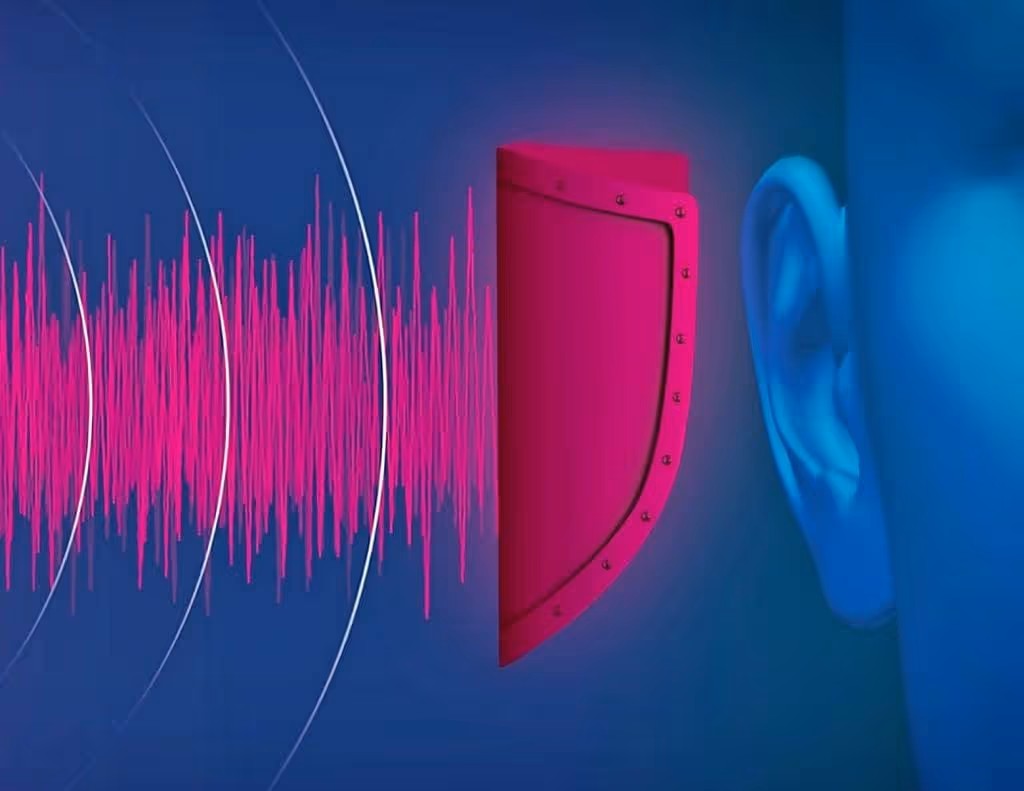
By triggering this protective reflex pre-emptively, Mercedes engineers have found a way to reduce the risk of permanent hearing damage by up to 60%, according to their research.
What makes this feature particularly innovative is how it leverages human physiology rather than trying to combat physics.
Instead of attempting to reduce the actual collision sounds which would be virtually impossible, the system prepares the human body to protect itself using its natural mechanisms.
The pink noise itself is barely noticeable in the chaos of a pre-collision moment, yet its protective effect is significant.
Mercedes-Benz introduced this technology in 2016, gradually expanding it across its lineup, yet many owners remain unaware of its existence.
It operates completely automatically, requiring no activation or maintenance, working silently in the background until the moment it’s needed.
The feature represents a holistic approach to safety that goes beyond the obvious concerns of physical impact to address subtler aspects of passenger wellbeing.
Pre-Safe Sound exemplifies how modern vehicle safety has evolved beyond mechanical protections to incorporate sophisticated physiological and psychological aspects of human protection, creating multiple layers of safety that work in concert during crisis moments.
7. Subaru’s Hidden Cargo Light Flashlight
Tucked discreetly into the ceiling of many Subaru models’ cargo areas is one of the brand’s most practical yet overlooked features a removable LED flashlight that doubles as the cargo area light.
This thoughtful dual-purpose design perfectly embodies Subaru’s outdoorsy, adventure-ready ethos.
What appears to be a standard cargo area light detaches from its housing with a simple sliding mechanism, transforming instantly into a portable, rechargeable LED flashlight.
The light automatically charges whenever it’s docked in its ceiling mount and connected to the vehicle’s electrical system, ensuring it’s always ready for use during roadside emergencies, camping trips, or unexpected nighttime situations.
The engineering behind this feature is cleverly straightforward. The flashlight contains a battery pack that charges from the vehicle’s electrical system when docked.
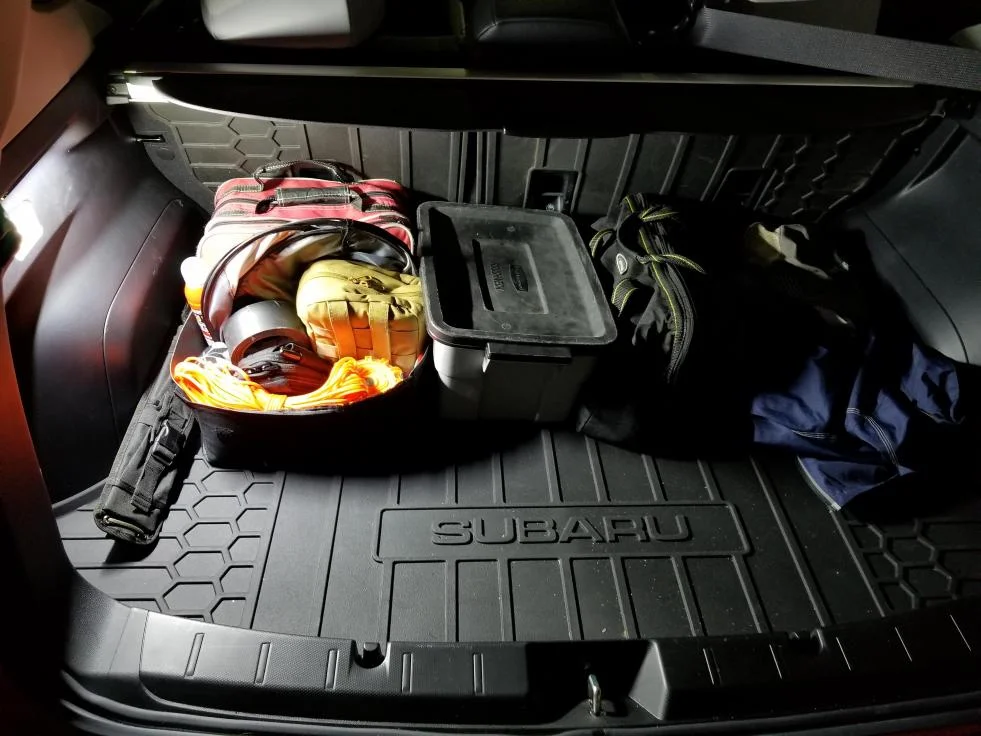
The mounting system uses spring-loaded contacts rather than plug-in connectors, eliminating wear-and-tear concerns from repeated removal and replacement.
When removed, the flashlight activates automatically; when replaced, it returns to functioning as the cargo area light.
What makes this feature particularly Subaru-appropriate is how it aligns with their customer base of outdoor enthusiasts and adventure-seekers.
Subaru clearly understands that their typical customers are more likely than most to find themselves setting up tents after dark, walking dogs on unlit rural roads, or going through trailheads in the early morning hours.
The flashlight’s robust construction water-resistant and drop-tested reflects an understanding of real-world use beyond the vehicle itself.
Despite its practicality, many Subaru owners remain unaware of this feature until they accidentally discover it or have it pointed out by a dealer or fellow enthusiast.
The discovery often creates a moment of brand appreciation, reinforcing Subaru’s reputation for thoughtful design that anticipates real-world needs.
This feature has evolved over several generations of Subaru vehicles, becoming more energy-efficient and brighter with each iteration while maintaining the same basic functionality.
It represents a perfect harmony between practical utility and emergency preparedness that defines the Subaru ownership experience.
8. Honda’s Magic Seats and Hidden Storage
Honda has mastered the art of maximizing interior space through its ingeniously designed “Magic Seats” system, available in models like the Fit, HR-V, and Civic.
These multi-configurable seats transform the vehicle’s interior to accommodate objects of various shapes and sizes that would normally require a much larger vehicle.
The system allows the rear seat bottoms to fold upward, creating a tall center space perfect for transporting items like bicycles, tall plants, or even a small piece of furniture.
Alternatively, both front and rear seats can fold completely flat, creating an impromptu bed or allowing long items to stretch from the dashboard to the rear hatch.
What many owners don’t realize is that beneath these versatile seats lies another layer of functionality: a network of hidden storage compartments.
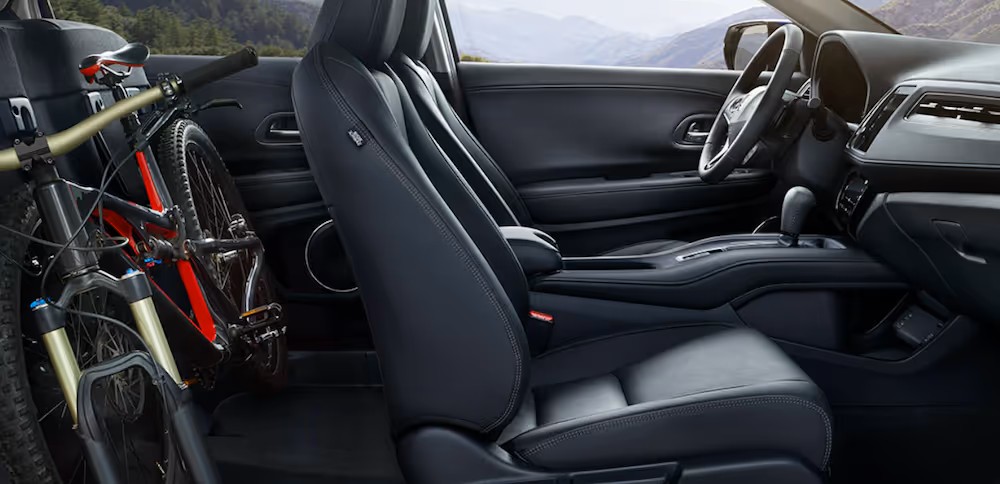
In the Honda HR-V, for example, a secret compartment beneath the rear seat cushion can store valuable items out of sight.
The Civic hides a clever sliding tray beneath the center console, perfect for stashing smartphones or small electronics, while providing easy access to USB ports and power outlets.
Perhaps the most impressive storage solution appears in the Honda Odyssey minivan, where engineers have incorporated what they call the “Hidden Trash Bag Ring.”
This simple but brilliant feature allows owners to hang a standard grocery bag from a small, retractable hook to create an impromptu trash receptacle that doesn’t take up floor space.
When not in use, the ring disappears almost completely into the center console. Another overlooked feature is the insulated storage compartment available in certain trim levels, capable of keeping beverages cold or hot foods warm during longer journeys.
These compartments are often camouflaged as regular storage bins but include special insulation and seals to maintain temperature.
Honda’s attention to storage detail extends to the cargo area as well, where many models feature a dual-height adjustable floor panel.
This allows owners to create a perfectly flat loading surface or a deeper well for taller items while concealing additional storage spaces beneath.
These thoughtful storage solutions demonstrate Honda’s deep understanding of how people use their vehicles in daily life and represent the company’s philosophy of maximizing utility without compromising on style or comfort.
9. Ford’s Hidden Message Bottle Openers
Discreetly integrated into the liftgate structure of several Ford SUV models is one of the automotive industry’s most whimsical hidden features small, built-in bottle openers that serve as both practical tools and playful Easter eggs for observant owners.
This feature first appeared on the Ford Bronco Sport, where engineers cleverly incorporated a small but sturdy bottle opener into the liftgate jamb.
The metal tab, stamped with a subtle outline of the vehicle’s profile, blends so seamlessly with the surrounding structure that most owners never notice it until that perfect moment when someone needs to open a beverage at a tailgate party or campsite and a knowing Ford owner reveals this hidden capability.
What makes this feature particularly interesting is that it represents a different kind of automotive innovation one focused not on performance metrics or technology integration but on enhancing real-world social experiences around the vehicle.
Ford clearly understands that for many owners, especially those purchasing adventure-oriented vehicles like the Bronco Sport, the vehicle serves as a hub for outdoor social gatherings where such a tool might prove unexpectedly useful.
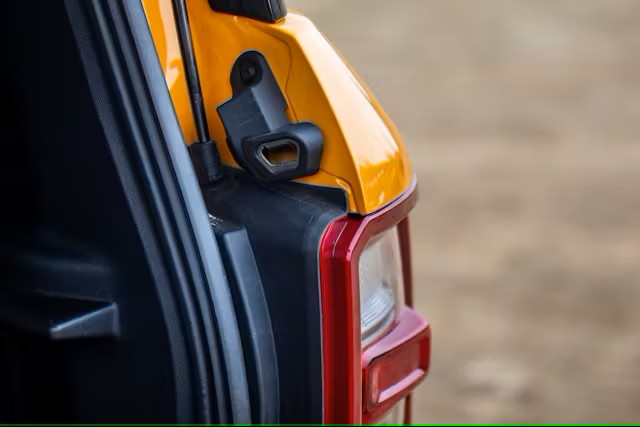
The engineering itself is elegantly simple. The opener is integrated directly into the vehicle structure rather than added as a separate component, eliminating any risk of failure or detachment.
The metal construction is robust enough to withstand years of use without deformation, and its location ensures it won’t damage any interior components.
Ford has since expanded this feature to other models, including certain Expedition and Explorer trims, sometimes relocating it to different areas of the vehicle but always maintaining the “hidden in plain sight” approach that makes discovery so delightful.
In some variants, Ford has added subtle messages or coordinates near the opener that correspond to notable outdoor locations, creating a scavenger hunt-like experience for owners.
This feature reflects a growing trend in automotive design where engineers look beyond transportation functionality to consider how vehicles integrate into owners’ lifestyles and social activities.
It’s a small touch that costs the manufacturer almost nothing to implement yet creates significant brand affinity and word of mouth marketing when owners proudly demonstrate their vehicle’s hidden capabilities to impressed friends.
10. Nissan’s Easy Fill Tire Alert System
Hidden within Nissan’s seemingly standard tire pressure monitoring system lies one of the most practical yet underappreciated innovations in everyday automotive convenience the Easy Fill Tire Alert system that transforms the often frustrating task of maintaining proper tire pressure into a nearly foolproof operation.
Unlike conventional tire pressure monitoring systems that simply warn drivers of low pressure, Nissan’s system actively assists during the inflation process.
When you begin adding air to a tire, the vehicle detects the pressure change and provides real-time feedback through a series of horn beeps and flashing hazard lights.
A single beep indicates inflation is in progress, while four rapid beeps and flashing lights signal the tire has reached its optimal pressure.
Should you accidentally overinflate, the system alerts you with three beeps, indicating air should be released.
The engineering brilliance behind this feature lies in its use of existing vehicle systems the horn, lights, and tire pressure sensors reconfigured through software to create an entirely new functionality without adding manufacturing costs or complexity.
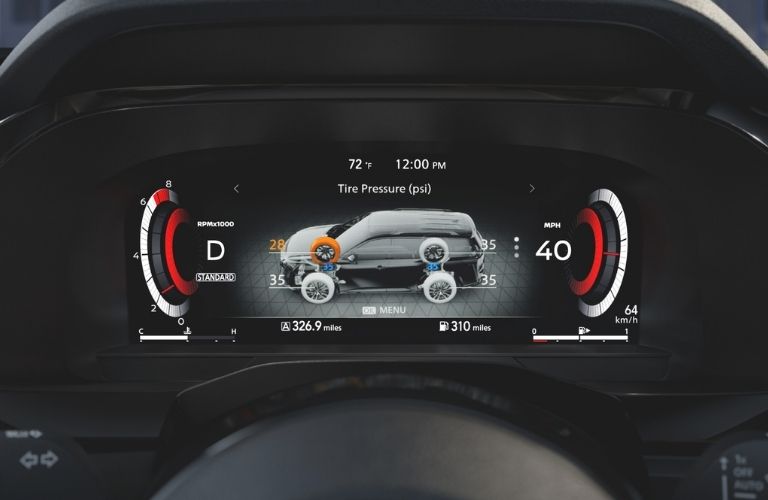
The system eliminates the need for separate tire pressure gauges (which many drivers don’t own or can’t locate) and removes the guesswork from proper inflation.
What makes this system particularly valuable is how it addresses a critical safety and efficiency factor most drivers neglect.
Industry studies show that more than 50% of vehicles on the road have improperly inflated tires, affecting handling, braking distances, fuel economy, and tire longevity.
By making proper inflation nearly effortless, Nissan has created a rare feature that improves both safety and operating costs throughout the vehicle’s lifetime.
Despite its practicality, many Nissan owners remain unaware of this feature until they happen to notice the alerts during routine maintenance, or have it demonstrated by service technicians.
The system operates on most Nissan models produced since 2013, including the popular Altima, Rogue, and Pathfinder lines.
This feature exemplifies how thoughtful automation of everyday tasks can significantly improve the ownership experience without adding technological complexity or cost addressing real-world pain points through elegant repurposing of existing systems rather than adding new components.
11. Jaguar Land Rover’s “Transparent Hood” Virtual Camera System
Concealed within the advanced driver assistance systems of select Jaguar Land Rover vehicles is one of the most technically sophisticated yet least known features in modern automobiles a “transparent hood” system that effectively allows drivers to see through the vehicle’s hood during challenging off-road maneuvers or tight parking situations.
This remarkable technology utilizes a network of forward-facing cameras mounted beneath the vehicle’s front end, capturing a real-time view of the terrain directly under and ahead of the front wheels.
These images are then digitally processed to create a seamless visualization that’s projected onto the lower portion of the windshield via the head-up display system or central touchscreen, effectively rendering the hood “transparent” from the driver’s perspective.
The engineering complexity behind this feature is extraordinary. The system must precisely calculate vehicle position, movement, and orientation to properly align the camera images with the driver’s actual field of vision.
Additionally, sophisticated image processing algorithms clean up the video feed, enhance visibility in varying light conditions, and add helpful overlay elements like tire position indicators and anticipated wheel paths.
What makes this feature particularly valuable is how it addresses a fundamental limitation in vehicle design.
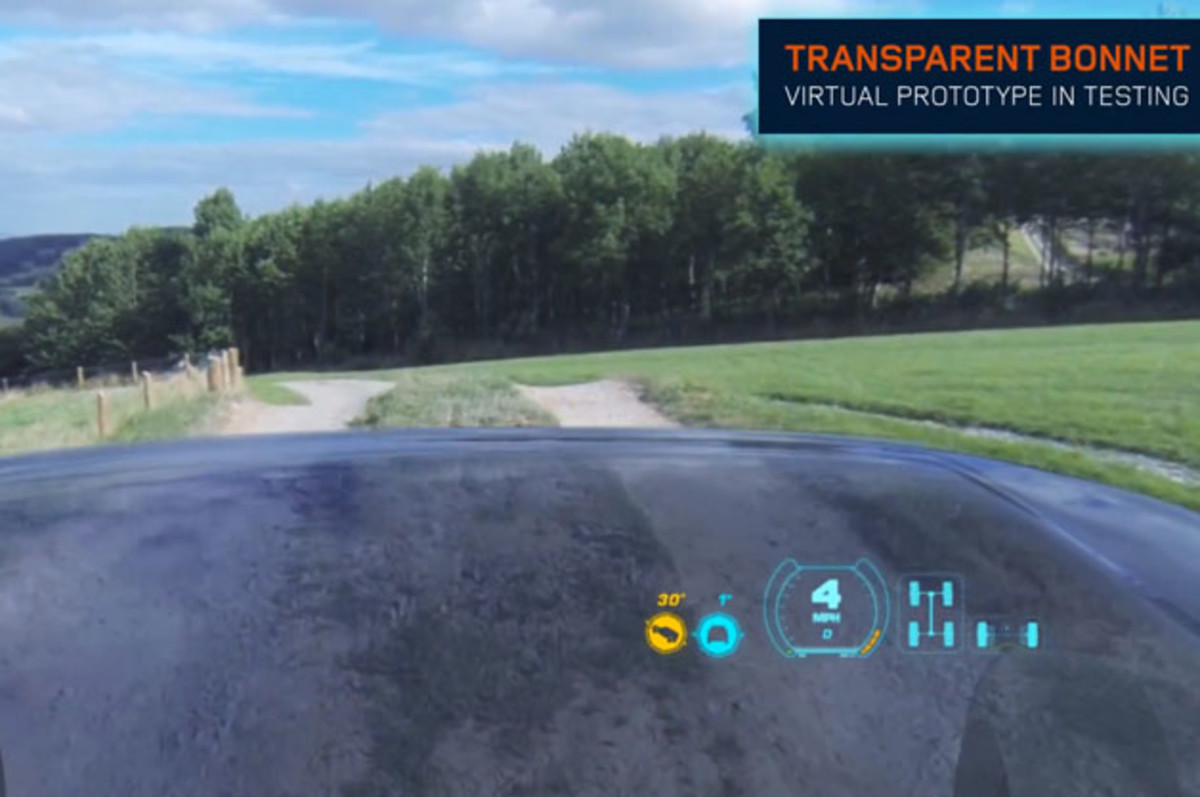
The hood of any vehicle creates a substantial blind spot directly in front of the driver an area critically important during off-road navigation where unseen obstacles can cause significant damage.
By virtually eliminating this blind spot, the transparent hood system dramatically improves driver confidence and precision when traversing challenging terrain.
Despite its impressive capabilities, many owners of equipped vehicles remain unaware of this feature until specifically introduced to it during dealership demonstrations or off-road training events.
The system is primarily available on higher-end Range Rover models and select Jaguar SUVs, typically bundled within premium technology packages.
This feature exemplifies the evolution of automotive technology beyond performance metrics and convenience features into territory that fundamentally changes how drivers perceive and interact with their vehicles.
It represents a stepping stone toward fully augmented reality driving experiences that will likely become commonplace in future vehicle generations.
12. Hyundai and Kia’s Solar Panel Roof Charging System
Seamlessly integrated into the panoramic glass roofs of select Hyundai and Kia hybrid and electric vehicles is one of automotive engineering’s most forward-thinking yet understated innovations a solar charging system that continuously generates electricity while the vehicle is parked or driving.
This technology embeds high-efficiency photovoltaic cells directly into the glass roof panel, creating a power generation system that supplements the vehicle’s conventional charging methods.
Unlike aftermarket solar panels that might appear visually obtrusive, this factory-integrated system maintains the vehicle’s sleek aesthetics while adding functionality that directly addresses range anxiety one of the primary concerns for electric vehicle owners.
The engineering achievements required to implement this feature are substantial. The solar cells must withstand years of exposure to harsh environmental conditions while maintaining transparency sufficient for a pleasant cabin environment.
The power management system intelligently directs the harvested energy either to the main drive battery or to a separate battery that powers climate control and auxiliary systems, depending on the vehicle’s state and needs.
While the energy contribution might seem modest approximately 2-4 miles of additional electric range per day under optimal conditions the cumulative effect is significant.
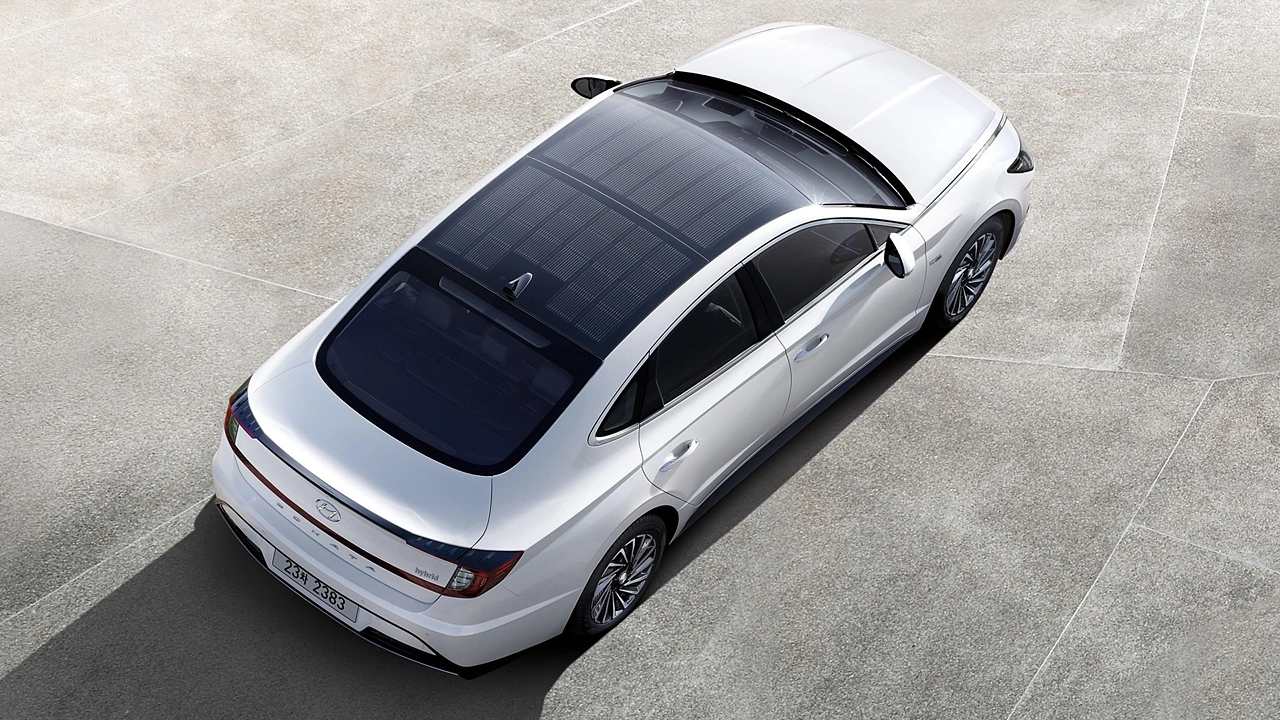
Over a year of typical use, the system can add hundreds of miles of “free” electric range, particularly valuable for owners who park their vehicles outdoors in sunny locations.
More importantly, the system can prevent battery depletion during extended parking periods, addressing the common issue of returning to a partially discharged vehicle.
What makes this feature particularly intriguing is how it represents a partial solution to electric vehicles’ dependency on charging infrastructure.
Even when disconnected from the grid, these vehicles continue harvesting energy, creating a small but meaningful degree of self-sufficiency that conventional vehicles simply cannot match.
Despite its innovative nature, this feature remains relatively unknown outside enthusiast circles, partly because Hyundai and Kia have been surprisingly reserved in their marketing emphasis.
The system is available primarily on the Hyundai Sonata Hybrid, Kia Niro EV, and Kia Soul EV in select markets, though expansion to additional models appears likely as the technology matures.
This solar integration exemplifies how automotive design is increasingly embracing sustainable energy principles, creating vehicles that don’t merely consume energy more efficiently but actively generate it as well.
Also Read: 10 Luxury SUVs With Stunning Interiors and Cutting-Edge Features

